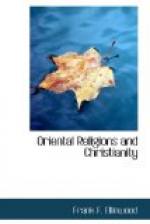So strong an effort is made to prove that Christianity has borrowed both its divine leader and its essential doctrines from India, that a moment’s attention may well be given to the question here. One allegation is that the Evangelists copied the Buddhist history and legends in their account of Christ’s early life. Another is that the leaders of the Alexandrian Church worked over the gospel story at a later day, having felt more fully the influence of India at that great commercial centre. The two theories are inconsistent with each other, and both are inconsistent with the assumption that Christ Himself was a Buddhist, and taught the Buddhist doctrines, since this supposition would have obviated the need of any manipulation or fraud at any point.
In replying as briefly as possible I shall endeavor to cover both allegations. In strong contrast with these cheap assertions of Alexandrian corruption and plagiarism is the frank admission of such keen critics as Renan, Weiss, Volkmar, Schenkel, and Hitzig,[92] that the gospel record as we have it, was written during a generation in which some of the companions of Jesus still lived. Renan says of Mark’s Gospel that “it is full of minute observations, coming doubtless from an eye-witness,” and he asserts that Matthew, Mark, and Luke were written “in substantially their present form by the men whose names they bear.” These Gospels were the work of men who knew Jesus. Matthew was one of the Twelve; John in his Epistle speaks of himself as an eye-witness. They were written in a historic age and were open to challenge. They were nowhere contradicted in contemporary history. They fit their environment.
How is it with the authenticity of Buddhist literature? Oldenberg says, “For the when of things men of India have never had a proper organ,” and Max Mueller declares to the same effect, that “the idea of a faithful, literal translation seems altogether foreign to Oriental minds.” He also informs us that there is not a single manuscript in India which is a thousand years old, and scarcely one that can claim five hundred years. For centuries after Gautama’s time nothing was written; all was transmitted by word of mouth. Buddhists themselves say that the Pali canonical texts were written about 88 B.C.[93]




